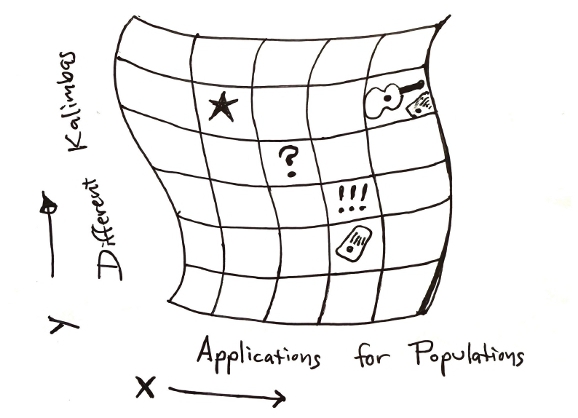
Use of this website constitutes acceptance of the Privacy Policy and User Agreement. Copyright © 2020 Kalimba Magic. All Rights Reserved.
Not all kalimbas are laid out in the same way, but a lot of kalimba makers follow the lead of Hugh Tracey in laying out the notes to require an alternating left-right pattern to go up or down the scale. If you have an alternating note layout, two or three adjacent notes on one side of the kalimba will sound great together.
This is a chord – at least three adjacent notes. Easy!
But how should one play three or more notes simultaneously on a kalimba?
The answer is a technique called the “glissando.” On the harp, a glissando is when you drag your finger or thumb up or down the adjacent notes. On the trombone, a glissando is when you play one note and keep playing as you push the slide in or out, raising or lowering the pitch to reach a different note.
On the kalimba, a glissando is playing a series or two or more adjacent notes by touching one with your thumb nail and then dragging the nail over adjacent tines. Pay attention to which tine you start on and which tine you end on.
When you play three adjacent tines on a diatonically-tuned kalimba, you play a triad – a three-note chord. When you play four adjacent tines, you play a 7th chord – major 7th, minor 7th, or dominant 7th, depending on where you are on the kalimba. The good news – you don’t need to know those different chord types, just know that the kalimba knows how to play them, and you can access them just by playing four adjacent tines. Five tines in a row make a 9th chord.
(BTW, diatonic means it has all the notes, and only the notes in the regular major scale, known commonly as “Do Re Mi Fa So La Ti Do”.)
The glissando is more easily accomplished if you have long thumb nails than if you don’t. If not, Alaska Piks can work, or get some glue-on nails from Walgreens. Use a gentle touch in your glissando.
The video below shows me playing “O Danny Boy” on the Bb Treble Kalimba. This song utilizes chords at the beginning of each measure (the first three notes are a pickup and the chord comes in on “boy” as in “O Danny BOY“). Most of the chords, including the one on “boy”, are accomplished with glissandos, sometimes with both the right and the left making a glissando at almost the same time.


Sign up for our newsletter and free resources with your email address:
We pinky promise not to spam you and to only send good stuff.
Use of this website constitutes acceptance of the Privacy Policy and User Agreement. Copyright © 2020 Kalimba Magic. All Rights Reserved.
Notifications